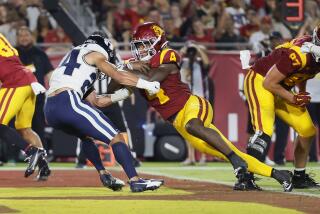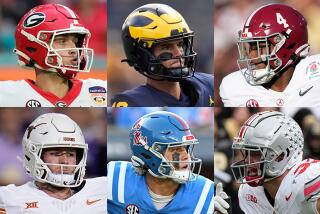SCHEDULES: How to Win a National Championship
- Share via
They celebrated Independent’s Day on Jan. 3 in 1989, which, despite what the calendar says, really wasn’t much of a change from tradition.
Or didn’t you notice the leaders when the final Associated Press top 20 for the 1988 college football season was released that day?
1. Notre Dame.
2. Miami.
3. Florida State.
4. Michigan.
5. West Virginia.
Except for the fourth-ranked Wolverines, champions of the Big Ten Conference, all are independents, a group that comprises only 23% of the 104 Division 1-A football teams. Independents feature the country’s three best records over the last two seasons--Miami (23-1), Florida State (22-2) and Syracuse (21-2-1).
And consider the last seven AP national champions and their affiliations:
1988: Notre Dame, independent.
1987: Miami, independent.
1986: Penn State, independent.
1985: Oklahoma, Big Eight.
1984: Brigham Young, Western Athletic Conference.
1983: Miami, independent.
1982: Penn State, independent.
In the 15 seasons before 1982, conference teams won 12 of the titles, with Notre Dame in 1977 and ’73 and Pittsburgh in 1976 breaking through.
“I don’t think there’s any doubt that being an independent helped our quest to win the national championship,” Notre Dame Coach Lou Holtz said.
The main reason is scheduling, the only outward difference between conference teams and independents. The independents are not bogged down by a portion of the schedule handed them by the league office. That much, coaches from both sides agree, give independents a big advantage toward finishing No. 1.
“I think so,” said Coach Larry Smith of USC, which next season will face Penn State and Ohio State on the road and Notre Dame in addition to playing in one of the toughest conferences in the country.
“The fact that they (independents) may play five or six tough games is there, but the other four or five opponents can be varied and sprinkled in however they want. They don’t have to get cranked up to play their best football week in and week out to still win the national championship.”
Which is why Miami has a bye before playing Florida State Oct. 24 and a home game against San Diego State before ending the regular season Nov. 25 against Notre Dame. And why Florida State meets Virginia Tech before facing Auburn Oct. 21, although the Seminoles play Miami the next week. And why West Virginia and Syracuse have byes before their Nov. 23 showdown.
Teams with conference commitments don’t always have such flexibility. USC’s two biggest regular-season games of 1988 came back-to-back, UCLA for a trip to the Rose Bowl and Notre Dame to remain undefeated. The Trojans won the first but lost the second, putting them out of the running for the national championship.
“I’m sure that most teams that play someone like Notre Dame at the end of the season don’t want a school with the caliber of UCLA the week before,” Holtz said.
That is the advantage independents hold. With a little foresight and luck, a school with a talented team can almost schedule a national championship.
By scheduling the East Carolinas and University of the Pacifics of the world, an 8-4 team can become 10-2. That record, no matter the competition, is enough to vault into the top 10.
“There should be some credibility factor,” said Florida State Coach Bobby Bowden, whose Seminoles are expected to contend for the national championship with a schedule that includes Clemson, Louisiana State, Syracuse, Auburn and Miami. “We play at least three teams that’ll be in the top 10 and five or six that may be in the top 20. People don’t realize it, but there are some teams who don’t play anybody in the top 10.
“The other side is that nobody thinks their schedule is very weak. You can’t convince some people they are just playing a streak of weak teams.”
Did somebody mention Nebraska?
The lineup that awaits the Cornhuskers, a member of the Big Eight, has some coaches shaking their heads in contempt, not to mention with some envy. Nebraska plays Northern Illinois, Utah, at Minnesota, Oregon State, Kansas State, at Missouri, at Oklahoma State, Iowa State, at Colorado, Kansas, Oklahoma. Even the annual meeting against the Sooners figures to be the easiest in years.
So Nebraska, which had seven of the games scheduled by the conference, could go into a bowl game undefeated. The voters for the wire-service polls will see the record and no doubt vote favorably.
“Is it fair?” one coach asked. “No, not especially. But if they win all the games, they’ll get it (the national championship.)”
The debate over such circumstances has raged since 1984: Remember Brigham Young. Not the man, the team. Not the team, the schedule--a 13-0 season while playing in the Western Athletic Conference.
Coach LaVell Edwards of BYU still hears the criticism that the 1984 Cougars played an easy schedule, and it still doesn’t bother him.
“That’s fine,” he said. “Because of all that controversy after we finished the year, there was more written and said about BYU maybe than any team that’s won the national championship. At least people were talking about us from coast to coast.”
But if you remember BYU and its schedule, you have to remember East Carolina and its. A lot other schools, obviously looking for Saturday afternoon tackling dummies, have.
Next season, East Carolina, an independent which went 3-8 in 1988, will play at Florida State, at Georgia and at South Carolina. In 1991, they’ll get Illinois, South Carolina, Syracuse and Pittsburgh. A year after that, Syracuse, South Carolina, Pittsburgh and West Virginia.
There’s still time for last-minute shoppers, though. East Carolina has an open date Oct. 3, 1992.
More to Read
Go beyond the scoreboard
Get the latest on L.A.'s teams in the daily Sports Report newsletter.
You may occasionally receive promotional content from the Los Angeles Times.










